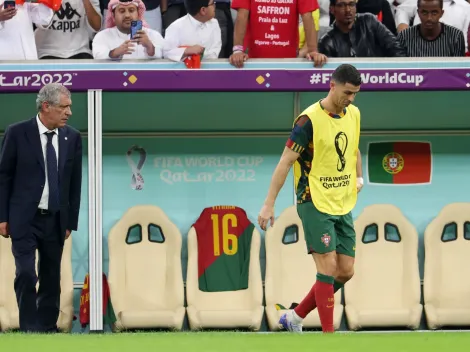The phenomenon of a FIFA World Cup is multidimensional, as it goes beyond the strictly sporting. The memories it leaves behind are made up of celebrations, spectacular plays, mistakes, goals, songs, mascots and official posters. What memories will you have of Qatar 2022?
In order for the millions of soccer fans and lovers of this legendary tournament to enjoy it, there are thousands of people who do a titanic job to get everything ready so that each edition of the FIFA World Cup can be considered a success.
With 92 years of history, the FIFA World Cup has thousands of stories to tell, but what the following lines of this story will focus on is the graphic footprint left by each edition, that is, the official posters of each of the tournaments, including Qatar 2022. Discover them.
Official posters in FIFA World Cup history
The vast majority of the cultural manifestations related to the FIFA World Cup were born when this tournament was already several years, or editions, old. The first official song arrived until England 1966, as did the first mascot. Likewise, the first ball designed exclusively for the tournament was the one used in Mexico 1970.
However, since Uruguay 1930, and evidently until Qatar 2022, the FIFA World Cup has counted on the work of true artists who have been in charge of capturing the spirit of the tournament to blend it with the culture of the host country and then capture it on canvas to eternalize the moment. Art focused on soccer.
Uruguay 1930
The venue for the first World Cup was awarded by FIFA to Uruguay for being the then two-time champion in soccer at the Olympic Games (1924 and 1928) and also for the centenary of its independence. An iconic poster with Art Deco overtones was the first graphic image of an edition of this tournament.

Uruguay 1930. (FIFA)
Italy 1934
The second edition of the FIFA World Cup took the world to Europe, where an Italy permeated by the politics of its then Prime Minister Benito Mussolini organized the tournament. The poster was in keeping with these inclinations: closer to the formal and strict.

FIFA World Cup Italy 1934. (FIFA)
France 1938
On the eve of a massive global war, France was allowed to host the FIFA World Cup. Its official poster returned to the Art Deco trend with a fantastic design that exalted the ball as the epicenter of the world, at least for the 15 days of the tournament.

FIFA World Cup France 1938. (FIFA)
Brazil 1950
Once the turbulence of the war that plagued mankind had passed, the mood and the opportunity to celebrate a FIFA World Cup returned. Brazil served as host and eternalized its edition with a design much closer to the caricature than to the trends used in the previous three editions.

FIFA World Cup Brazil 1950. (FIFA)
Switzerland 1954
Undoubtedly, the official poster for the FIFA World Cup Switzerland 1954 stood out for its iconic configuration: straight lines, well-established colors and the first ode to the true source of joy in soccer: the goal.

FIFA World Cup Switzerland 1954. (FIFA)
Sweden 1958
Again, there was a break with what had been established. The 1958 edition of the FIFA World Cup in Sweden was in charge of marking a distance with its sobriety, classic of the Scandinavians, with a simple official poster.

FIFA World Cup Switzerland 1958. (FIFA)
Chile 1962
Soccer cannot be understood without the entire social, political and cultural context that surrounds it. Thus, the official poster of the FIFA World Cup Chile 1962 was carried away by the current space conquest that was beginning to worry humanity at that time.

FIFA World Cup Chile 1962. (FIFA)
England 1966
The sobriety of the country host at its best. Perhaps one of the simplest official FIFA World Cup poster of all. Only the ball as the protagonist of a clear background, with the first mascot in the history of the tournament as a companion.

FIFA World Cup England 1966. (FIFA)
Mexico 1970
If any of the official FIFA World Cup posters competes with England’s for the position of king of simplicity, it is this one. Mexico 1970 made an ode to the country’s traditionally striking colors and designs of itsDead’s Daypaper decorations but with a ball as the protagonist.

FIFA World Cup Mexico 1970. (FIFA)
Germany 1974
A total contrast was this official poster. A black, lapidary background, notably altered by a rain of colors that gave shape to a soccer player kicking a ball. There is no doubt that the FIFA World Cup Germany 1974 provided one of the most iconic posters.

FIFA World Cup Germany 1974. (FIFA)
Argentina 1978
Abstract shapes, such as dots, and few colors, if any three. Just that, and a great imagination is needed to give life to an official FIFA World Cup poster. The one for Argentina 1978 brilliantly represented the essence of the game.

FIFA World Cup Argentina 1978. (FIFA)
Spain 1982
Surrealism in Spain could not be presented by anyone other than Joan Miró, who let out all his creative genius attached to his favorite trend in the official poster that gave the world the FIFA World Cup Spain 1982.

FIFA World Cup Spain 1982. (FIFA)
Mexico 1986
The second World Cup hosted by Mexico delivered an official poster that broke any ties with its predecessors. The photograph that was the central object of the poster unites the ball with the Mexican pre-Hispanic culture, a postcard taken by the American Annie Leibovitz.

FIFA World Cup Mexico 1986. (FIFA)
Italy 1990
With no longer a trace of what it was under the spell of Mussolini, Italy was once again hosting a FIFA World Cup and wanted to make its new face clear from its official poster, in which it creatively dressed the Colosseum as the site of a soccer battle.

FIFA World Cup Italy 1990. (FIFA)
USA 1994
Pure symbolism. The United States showed the world that in addition to football, basketball and baseball, it has soccer at its heart, with an official poster for the FIFA World Cup it organized in which the colors of its flag stood out prominently.

FIFA World Cup USA 1994. (FIFA)
France 1998
The nineties were saying goodbye to a social and cultural phenomenon such as the FIFA World Cup. The official poster for France 1998 was made based on abstractionism, but full of color and a typography that scandalously winks at the American series Friends.

FIFA World Cup France 1998. (FIFA)
Korea-Japan 2002
The first FIFA World Cup organized in Asia by two host countries had to show a consensus in its graphic line so as not to disadvantage any of the organizers. So they opted for the simple: brushstrokes in the official colors of the tournament that gave a sober and elegant look to their official poster.

FIFA World Cup Korea-Japan 2002. (FIFA)
Germany 2006
The FIFA World Cup is a bright dream for many, whether they participate in it or enjoy it. That’s what the official Germany 2006 poster tried to capture: a ball made up of stars that illuminates the world’s firmament with the light that only soccer can emit.

FIFA World Cup Germany 2006. (FIFA)
South Africa 2010
The African continent has only been able to host one FIFA World Cup. And the official poster went down in history as one of the most symbolic in history: the shape of the continent in the form of a footballer dominating the ball with his head, a canvas illuminated with the most representative colors of the region. A jewel.

FIFA World Cup South Africa 2010. (FIFA)
Brazil 2014
The sum of details built a very representative concept in the official poster of Brazil 2014. Silhouettes of animals and flowers from the host country of that year’s FIFA World Cup formed a pair of legs that dispute a ball. Color, as a sign of the joy of the Brazilian people, was also present.

FIFA World Cup Brazil 2014. (FIFA)
Russia 2018
The most vintage official FIFA World Cup poster ever. Russia 2018 paid a tremendous tribute to its most representative footballer, goalkeeper Lev Yashin, and to the design of the Uruguay 1930 poster, in terms of colors and shapes.

FIFA World Cup Brazil Russia 2018. (FIFA)
Qatar 2022
Qatari artist Bouthayna Al Muftah was commissioned to design the official poster for the 2022 FIFA World Cup, which has one main and seven complementary designs for the first time in history. Al Muftah described her work as follows: “I wanted each poster to show the celebration and love of soccer in Qatar. The main poster shows the ‘gutra’ and ‘egal’ (traditional headdress)waving in the air in celebration, something fans do here when a goal is scored.“

FIFA World Cup Brazil Qatar 2022. (FIFA)





